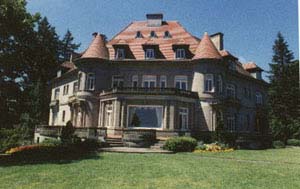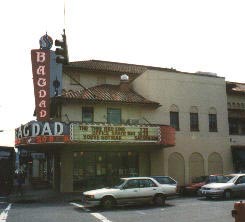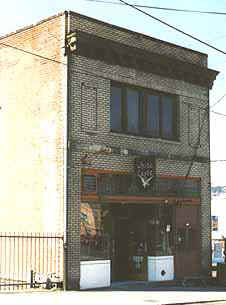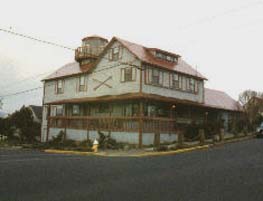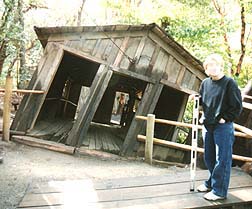__________
|
Portland Pittock Mansion (3229 NW Pittock Drive, Portland, OR) Historic Pittock Mansion is a 16,000 square foot building that overlooks Portland. Local craftsmen built it almost entirely of materials made from regional sources. Architect Edward T. Foulkes designed it. Perhaps because he had never designed such a large home before, Foulkes was not a prisoner of standard design. His plans incorporated an interesting mix of square stone walls, with a circular interior. Rooms were built off of a central grand staircase like spokes from a wheel.
The house incorporated many of the most modern features. There was a dumbwaiter to raise food to the upstairs bedrooms. The house was designed so that morning airflow acted to cool the house without fans in the summer. Instead of bells to call servants from anywhere in the house, the Pittock's had an internal phone system installed. A central vacuum system ran throughout the house. According to legend the vacuum was so powerful that if it were used when the windows were closed the air pressure change would be so strong that windows would implode. There were some homey touches. Georgiana Pittock made use of her frugal pioneer upbringing in the house. For many years she had saved the silver foil that her tea had come wrapped in. When the house was built, she had the foil used to paper the vaulted ceiling of the entryway of the house. The house was really the culmination of the life and work of the Pittocks. The Pittocks stood apart from many of their peers in a time when most of the rising rich of the Pacific Northwest were what I have come to call visionary-despots. I do not mean any disrespect to these people, or those who admire their accomplishments. Without the dedication and work and yes, the vision of progress they had, we would not have the benefits we enjoy today. At the same time, the men and women who undertook the development of the Pacific Northwest could be short sighted and ruthless in accomplishing their goals. They were in part a product of their time, which was much different than the times we live in today. Henry Pittock was instrumental in brining modernization to many industries in the Pacific Northwest. He helped found the Mazamas climbing club and was part of the first expedition to climb Mt. Hood. He frequently led the rose parade. The house was not completed until they had been married 58 years. After the sandstone mansion was completed, the Pittocks and some of their descendents moved in together. Georgiana lived in the house for four years, until her death in 1918. Henry survived her by one year and died in 1919. The house was purchased by the City of Portland in 1964 and restored with public and donated funds and labor. Since the house has opened to the public in 1965 there have been some stories of strange happenings throughout the mansion. A boyhood picture of Henry Pittock seems to move from place to place. It is usually kept on a bedroom mantle, but will move to different locations only minutes after it was last seen. The tour guides can be reticent about these happenings. One did admit that one morning she entered the mansion and saw a figure standing in one of the ground floor rooms as she turned on the lights only to find it was a new mannequin display. Perhaps that is why they are hesitant to talk about their own experiences. Visitors have come forward with their own stories. Some visitors have reported the strong smell of roses, when there were none in the house. This was Georgiana's favorite flower. Other people have reported the sound of heavy boots walking in or out of the rear entrance. A woman was looking at the picture displays in the basement level when she felt something. She turned around and saw the figure of an elderly woman, standing next to her. The woman vanished, before her eyes. A group of native Hawaiians had taken the tour and as they left one of the youths remarked; "My uncle is a shaman in Hawaii and he says that he can feel the spirits of the Pittocks here, and they are very happy." When I visited the mansion in the summer of 1998 I took a chance and asked one of the museum staff if the ghosts were acting up lately. I was told, "It's strange that you asked. One of the windows overlooking the front entrance shut and latched on it's own earlier this morning." When I took the tour I examined the window. It is situated on the first landing of the staircase on the main hall. It is a heavy glass pane that could have blown closed on it's own, but not likely. The latch is the kind that takes a human hand to lift and turn to close. I do not see how it could have latched on it's own. It was a hot summer day. Perhaps someone besides the staff felt that the air coming in was too warm and decided to close the window.
The Bagdad Theater (3702 SE Hawthorne, Portland) The Bagdad Theater is one of many Arabian Knights style of theaters built in the late 1920s, after silent fantasy classics like Douglas Fairbank's Thief of Baghdad. The Bagdad Theater will comfortably seat 700 + people in its auditorium and large balcony. Several rows of seats have been removed to make way for the permanent tables, set up in front of many seats for patrons to place their food and drink while watching movies.
Patty worked at the Bagdad in 1994 when McMenamin's first acquired it. She knew things would be different after the electricians began rewiring the theater. They turned off the main power switch to the house lights. At first the lights went out normally. Suddenly they came on again, then gradually flicked off and on for nearly an hour before they stayed off. The electricians were monitoring the circuit with a voltmeter and could not explain what happened. Patty's boyfriend worked with her at the Bagdad. One day he went up to the second floor restroom used by employees. It was not his favorite restroom because it did not have any ventilation. This time he got more ventilation than he could wish for. He was washing his hands when he felt a sudden chill. Then a cold wind began to blow through the closed room. It was so strong that the toilet paper on the rolls and the cloth towel on the circular towel rack were blown sideways. He never used that bathroom after that. I had the opportunity to visit several haunted buildings owned and operated by McMenamin's. They and the Bagdad Theater are described in greater detail in the full length version of my book.
The White Eagle Tavern (Portland, OR) The hauntings continue at Portland's favorite haunted night spot. In the early weeks of July of 1999 Jeff, the assistant manager and several other employees witnessed many strange events. At various times when the bar is empty, employees have smelled smoke. When they investigated, there was no evidence of a fire anywhere. It could have been some kind of a wiring short, but again there was no interruption of power. In addition to the burning smell, they would sometimes be assaulted by the overpowering odor of cheap perfume. The most interesting incident happened to Jeff. One afternoon he was standing just inside the kitchen area, counting tips. To his right was the stairway leading down into the basement. The basement had been a focus of strange activity in the past. Some time earlier, someone had wedged a spare menu board between the right hand side of the door sill and several pipes an inch or two from the wall. For some reason, Jeff turned his head and looked down the stairs. He watched the menu board fly across the doorway and strike flat against the left-hand wall with a loud slap. Jeff had always been skeptical about the past paranormal events at the White Eagle. He could always think of some rational explanations for them. This one has him stumped. He could see how the board may have become unbalanced and fallen to the floor, but not how it could have flown across the doorway. One of the other employees was standing at the bar, several feet behind him when this incident happened. There was no one close enough to have thrown the menu board to frighten him. She told me that she saw him look down the stairway and heard the crashing noise. She watched him turn to look at her, and his face was white as skim milk. She had never seen him look so alarmed before, or since.
High Desert Origin of an Urban Legend? (Eastern Oregon State Hospital, Pendleton, OR) Several years ago, Oregon State Highway 30 was the main route from Portland to Pendleton. A woman was driving the highway to Pendleton late one October night. When she was within sight of the hospital her car developed a flat tire. She was trying to change the flat tire, she accidentally lost the lug nuts. While she was trying to find the nuts with the aid of her flashlight, the batteries died. Just as she was about to give up hope, a figure appeared behind her. She could see that it was a man, dressed in a large wool coat, wrapped tightly around him. As he approached her, he picked up the tire iron...and the woman fainted. She awoke some time later, and found herself inside her car. The door was locked, the keys were in the ignition and she was wearing a heavy wool coat. She got outside of her car and found that the spare tire had been put on, and the jack and tire iron were in the trunk She got into her car and drove into Pendleton and stopped at an all night garage. She showed the garage station attendant the coat, left behind by her late night rescuer. He recognized the coat as being the same style that a man named Martin Poe used to wear. He told the woman that Poe had killed his wife in a murderous rage and been sent to the hospital, where he died after years of guilt. His dying wish had been to help other people to atone for his sins.
The Coast The Oar House Bed & Breakfast (502 SW 2nd, Newport, OR) If a building ever deserved to be haunted it is the Oar House. According to local legend the house was built in 1900 using boards and timbers that its owner collected on the beach after shipwrecks. The more shipwrecks, the more rooms were added. Today the house has five guest rooms. It was originally built as a temporary boarding house for the sailors or dock workers that visited Newport from time to time. In the late 1920s the clientele at the Oar House changed from sailors and dock workers to prostitutes and their customers. In the 1930s a young woman from the mid-west came to Newport to meet her fiancé, who was arriving in Newport either as a ship's passenger or a member of the crew. No one knows the young woman's name, so let's call her "Mary".
Mary needed a place to stay while she waited. She stopped at the Oar house and told her story to the Landlady/Madam. Mary was given a room on the third floor and in exchange for her room, Mary worked as a maid. She could see the harbor from the Widow's Walk just above her. The days turned to weeks and the weeks turned to months. Mary eventually realized that her fiancé was not going to meet her. She threw herself out the window of her small apartment and died when she hit the ground far below. Despite her death, Mary has not left the Oar House. Her ghost continues to haunt the entire building. One evening a former owner was in the guest sitting room reading a newspaper.. He looked up at the ceiling. An interesting feature of this room is a small glass hatch or trapdoor leading from the sitting room to the room directly above. He thought that he saw someone looking down at him from above. After searching the house he found his wife in the laundry room. She denied spying on him and he believed her. In order to get from the upstairs room with the trap door, she would have had to pass him in the sitting room to go down into the laundry room.
Southern Oregon Ashland Ashland was founded in 1852. It was unique because it was not settled because of the gold rush (as was Jacksonville a few miles north), but as a farming and lumbering community. Because of that, although it prospered from trade with the gold towns, when the gold disappeared the town survived. As time went by larger industry developed. First a sawmill, flour mill and in 1884 passenger trains began to stop there regularly. Near the turn of the century a large building was constructed to house the Chautauqua, a kind of town fair, swap meet and community fair. Southern Oregon State College was founded and student enrollment increased. Ashland's claim to fame is it's Royal Shakespearean Festival. In the 1930s the Chautauqua series building was condemned. Angus Bowmer, a professor at the college noticed that without its roof, the building resembled an Elizabethan theater. He was able to persuade the town to cease demolition of the structure and modify it into a true theater. He inspired the festival until his death in 1979. The first year of the festival in 1935, the costumes were made from discarded and donated clothing. Today the festival runs from February to November and attracts audiences from across the country and actors and actresses from around the world. Plunkett Center (at the intersection of Mountain Avenue and Siskiyou Blvd, Ashland, OR) Southern Oregon Universities Plunkett Center has been put to many uses since the University acquired the old building in 1966. It has been alumni and development offices on its second floor and the first floor is used museum displays by the local historical society. This building is also known as the Swedenburg House, taken from its former tenant, Dr. F. Swedenburg. Swedenburg was a prominent local physician who lived in the house from 1919 until he died in 1937. Since the University purchased the property there have been ghost stories surrounding it. Some skeptics believe the stories get more elaborate year after year. Believers who counter this opinion included a University professor and the head of campus security. Joey Ngan began his experiences with the Swedenburg house when he was a junior campus security guard. Ngan had the graveyard shift when he started out working for security. He always felt as if he was being watched when he went onto the second floor. He would announce himself and explain that he was just there to check out the building. If he did not do this he always felt as if something did not want him there. The house was restored in the early 1980s and a new security system was installed. Ngan and another officer had just finished checking the building and ensuring that the alarm system was operational. Later they drove by the house and saw a woman illumined by the porch light. She was sitting in beside a window in a first floor office. They saw her for a second and then she was gone. They entered the building and searched it for her. The door was locked and the building was empty. Political Science Professor Bill Muelemans came to the University in the early 1970s and collected several of the stories over the years. In 1973 the building was closed down and the electricity was turned off. Muelemans, a security guard and three students decided to hold a vigil in the house. They went to one of the second story rooms with candles, flashlights and a Ouija board. The board spelled out messages, including a statement that one of the students had tried to commit suicide in the past. This was true, though no one besides the student knew this. The board began moving and seemed to jump in the air about 18 inches. At that point they ran out of the building. The security guard was the last one out. As he was locking the door he felt as if his hand was frozen to the doorknob for about 30 seconds before he could break free. Many visitors have seen another specter. A young girl dressed in an old-fashioned pinafore dress with her hair in pigtails has been seen by many unrelated visitors. She is usually seen out of the corner of the visitor's eyes and only for a few seconds. There are rumors of burglar alarms going off and glowing apparitions seen by students late at night. It is hard to pin them down to a definite location.
The Oregon Vortex (near Jacksonville, OR)
Is this cabin level, or is the the deck tilted? The Oregon Vortex is a location in southern Oregon, near Jacksonville. It was made famous by an English Engineer named John Lister. Lister arrived in Oregon in 1929 to conduct mining surveys, when he discovered a dilapidated log cabin that had been an assay office for a turn of the century mining camp. Lister noticed that there were some strange anomalies in the magnetic field in the vicinity of the old cabin. He felt that this field, or vortex of energies went so far as to warp the fabric of space/time. He set up a series of displays that he felt might illustrate this. At the same time as Lister was charting the Oregon Vortex he set up displays outside and inside the boundaries to show observers its effects. This includes having two people of different heights standing on a concrete slap. One person is inside the vortex, the other person is outside. The person standing inside the vortex is always shorter than the person standing outside the vortex. When the two people change places, the person who was inside the vortex (and shorter) becomes taller than the person who outside the vortex (and formerly taller). There is a large collection of photographs that show strange light effects on film that were not visible to the photographer when the pictures were taken. According to the staff at the Oregon Vortex, this phenomenon is different than that encountered by visitors in the old log cabin. As an engineer Lister was familiar with the effects of light and complex angles on people's vision. He set up a series of complex optical illusions inside the log cabin. These optical illusions include standing a broomstick upright, at an angle and rolling a bottle uphill, among many other visual effects. These illusions have been copied by numerous amusement parks since Lister's death in 1959. Even skeptics would enjoy a visit to the Oregon Vortex to try and "discover" the secrets of some of the visual effects or explain the apparent expansion and contraction of people when entering the vortex. I have practiced with optical illusions myself over time, but if all of this is a trick, I don't see how it was done. If someone has an explanation, I would be interested in seeing how it was done myself. Another interesting note about the Oregon Vortex, it is haunted. Several visitors to the vortex have seen Lister standing at the top of the sloping floor of the old log cabin. He is usually seen resting against the wall, laughing and plucking his eyebrow. The visitors have asked the guide the identity of the man who somehow got ahead of the tour. One tour guide looked inside and recognized Lister from an old photograph. After the quick look, Lister disappeared. When the other tour guides have looked inside the cabin, there was no one there. Anyone leaving the cabin by the back door would have been seen.
Copyright © 1996-2001 by Jeff Davis | Maintained by J. Goodman |





